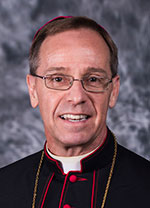Christ the Cornerstone
Encountering Christ in the Hispanic community

More than 200 dioceses will be engaged in the Fifth National Encuentro of Hispanic/Latino Ministry (V Encuentro), which will be celebrated in Grapevine, Texas, on Sept. 20-23. This is the fifth encuentro (the Spanish word for “encounter”) since 1972.
Encuentros involve evangelization, consultation and mission, and are intended to discern ways for the Church in the United States to better respond to the growing Hispanic presence, and to help Hispanic Catholics to strengthen their identity and their role as missionary disciples.
V Encuentro began in local parishes several years ago with more than 250,000 missionary disciples getting involved, accompanying, bearing fruit and rejoicing with their sisters and brothers in need of hearing the Good News of Jesus Christ. More than 40,000 of these leaders have now been selected as delegates to represent their parishes in diocesan Encuentros. These include long-standing as well as emerging leaders and people who were encountered during missionary activities.
As reported in The Criterion recently, nearly 200 Hispanic ministry leaders from 13 dioceses in Illinois, Wisconsin and Indiana—including the Archdiocese of Indianapolis—gathered at the University of Notre Dame for the Region VII Encuentro on June 8-10. I was privileged to attend this important gathering.
Among the main issues participants considered as priorities for our region were: evangelization and leadership development among youths and young adults; support and care for immigrants in the country without documents; accompaniment of families; the development of intercultural competencies in parishes; and the need to grow more vocations.
Like other regional Encuentros being held around the country, the gathering at Notre Dame was part of the process leading up to V Encuentro, the Fifth National Encuentro of Hispanic/Latino Ministry which will take place later this month.
Oscar Castellanos, director of our archdiocesan Office of Intercultural Ministry, says the gathering had a feeling of “openness and collaboration,” and a “sense of brotherhood and festivity.” I agree!
The purpose of the regional meeting was to continue the V Encuentro process initiated by the United States Conference of Catholic Bishops (USCCB). It encourages the Hispanic community to understand its call in the Church of the United States. Participants working in small groups selected their main challenges, priorities and strategies in ministerial areas that were discussed and agreed upon by all participants.
During the large-group sessions, participants in the different ministerial areas stressed the importance of reaching out to families at all ages and stages. They discussed ways to provide support in faith formation, access to sacraments, strengthening marriages, getting to know their struggles and the reasons why some might stop going to church—as well as ways to invite them back.
Strategies on how to develop and promote Hispanic vocations to the priesthood and the diaconate from within their communities also were considered. Many leaders expressed a hope to see more access to opportunities in Spanish to deepen and strengthen their knowledge of the Catholic faith at all levels.
Many participants also voiced the need to have priests, bishops and parish staffs be open to understanding their cultures, and they highlighted the need for more intercultural training and collaboration at all levels within parishes and dioceses.
Sixteen dioceses make up episcopal Region VII. It is estimated that more than 3 million Hispanics live in the region, according to U.S. census numbers. The population of Hispanics in the area has grown by 56 percent since 2000, and about 54 percent of them are Catholic, according to the National V Encuentro team.
Hispanic immigrants in the region are predominantly from Mexico; others are from countries in Central and South America. U.S. census figures show that the Archdiocese of Indianapolis has the fastest growing Hispanic population, with the number up by 185 percent since 2000. The Archdiocese of Chicago and the dioceses of Joliet and Rockford, Ill., have the largest Hispanic populations in the area.
High numbers of unskilled immigrants work on farms and in meatpacking industries in the region. They are among those considered to be on the peripheries; they face hardships such as the lack of an immigration status, fears of deportation and lack of access to the Mass and the sacraments.
Strategies and recommendations resulting from the regional Encuentros will be included in a final report to be submitted to the national V Encuentro team, and will be part of a working document to be used during the national Fifth Encuentro gathering later this month. The recommendations that emerge at the national level will provide a basis for a pastoral plan for Hispanic ministry in the U.S. for the coming years.
Let’s pray for the success of this important national encounter! †
